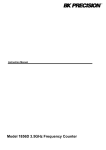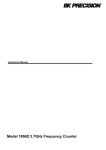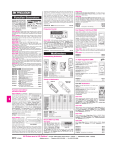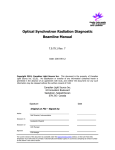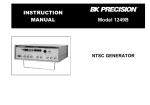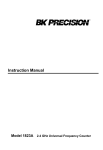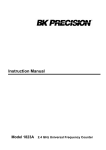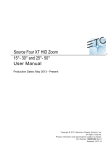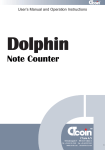Download BBK Electronics 1856D User's Manual
Transcript
Instruction Manual 1 Model 1856D 3.7GHz Frequency Counter WARRANTY Warranty service covers a period of one year from the date of original purchase. In case of technical failure within one year, repair service will be provided by our service center or sales outlet free of charge. We charge customers for repairs after the one-year warranty period has expired. We charge for repairs regardless of the warranty period if failure resulted from the user’s negligence, natural disaster or accident. For more professional repair service, be sure to contact our service center or sales outlet. 2 Introduction Thank you for purchasing our product. Electronic measuring instruments produced by us are high technology products made under strict quality control. We guarantee their exceptional precision and utmost reliability. For proper use of the product, please read this operation manual carefully. Note l l l l l To maintain the full precision and reliability of this product, use it within the temperature range of 10 °C to 35 °C (50 oF to 95 oF), and within a humidity of 45% to 85%. After turning on the power, allow a warm up period of about 30 minutes before use. This equipment should be used with a triple line power cord for safety. Due to ongoing product development and improvement, things such as exterior design and technical specifications can change without prior notice. If you have further questions concerning use of this product, visit www.bkprecision.com. Safety Summary Please take a moment to read these operating instructions thoroughly and completely before operating this instrument. Pay particular attention to WARNINGS concerning conditions and actions that pose a hazard to the user and CAUTIONS describing conditions and actions that may damage the instrument. l Before every use, inspect the instrument and other accessories for signs of damage or abnormality. l Keep your body isolated from ground. l Never touch exposed wiring, connections or any live circuit conductors. l Do not install substitute parts or perform any unauthorized modifications on the instrument. l Use caution when working above 60V DC or 30V AC rms. Such voltages pose a shock hazard. l Remember that line voltage is present on circuit points such as on-off switches, fuse, power transformers, etc., even when the equipment is turned off. l Remember that high voltage may appear at unexpected points in defective equipment. Safety Symbols DANGEROUS VOLTAGE SEE EXPLANATION IN MANUAL AC-ALTERNATING CURRENT GROUND DC-DIRECT CURRENT FUSE 3 CONTENTS 1. PRODUCT DESCRIPTION 1-1. Introduction ----------------------------------------------------1-2. Technical Specifications -----------------------------------1-3. Equipment Ratings ------------------------------------------1-4. Supplied Accessories ---------------------------------------- (5) (6) (9) (10) 2. INSTALLATION 2-1. Initial Inspection ----------------------------------------------2-2. Connecting AC Power --------------------------------------2-3. Cooling and Ventilation -------------------------------------2-4. Position ---------------------------------------------------------2-5. Warming-Up --------------------------------------------------- (10) (10) (10) (10) (11) 3. OPERATION 3-1. Controls, Indicators and Connectors --------------------3-2. Operating Instructions---------------------------------------3-3. Frequency Measurements ---------------------------------3-4. Period Measurements --------------------------------------3-5. Total Measurements ----------------------------------------3-6. RPM Measurements ----------------------------------------3-7. Use of RS-232C Serial Interfacing ------------------------ (11) (14) (14) (16) (16) (16) (17) 4. MAINTENANCE 4-1. Fuse Replacement ------------------------------------------- (18) 4-2. Adjustment and Calibration -------------------------------- (18) 4-3. Cleaning and Decontamination ---------------------------- (18) 5. OTHER 5-1. BNC Cable Considerations --------------------------------5-2. Attenuator Probes -------------------------------------------5-3. Line Frequency Measurements---------------------------- 1. PRODUCT DESCRIPTION 4 (19) (20) (20) 1-1. Introduction This reciprocal FREQUENCY COUNTER is a microprocessor-controlled instrument for frequency measurement. Due to uniquely developed LSI circuitry in an expanding/reciprocal system, high accuracy with 9-digit resolution is achieved with a one second gate time. It covers a frequency range of from 0.1 Hz to 3.5 GHz based on a 10 MHz TCO (Temperature Controlled Oscillator). Other features include: l RPM (Revolutions Per Minute) Measuring Function l External Frequency Standard Input with 9 Digit LED Display l Attenuator l Period l Total l Low Pass Filter l Line Filter Also provided is a self-test function for a quick check of several operating modes. Each mode can be selected by a front panel push button switch with automatic decimal points and indicators. The high accuracy, sensitivity and versatility of this counter make it an extremely valuable instrument to the scientist, engineer, experimenter and communications technician. Lightweight and compact size make it practical for use by the hobbyist or field technician. 5 1-2. Technical Specifications g INPUT A CHARACTERISTICS h FREQUENCY RANGE: 0.1 Hz to 100 MHz (DC coupled) 30 Hz to 100 MHz (AC coupled) h SENSITIVITY: 30 mV rms h COUPLING: AC or DC selectable. h IMPEDANCE: 1 MΩ resistance shunted by < 40 pF h ATTENUATOR: x1 or x10 switch selectable h LOW PASS FILTER: -3 dB point at approx. 100 KHz, switch selectable h ACCURACY: ± Time base error ± resolution (Table 1) h Resolution and Number of Displayed Digits Time Base Selector INT Gate Time Number of Display EXT INT 0.01S 5 EXT INT 0.1S 6 6 EXT INT 1S 7 7 EXT 10S 8 8 9 Digits Frequency (Input A) 0.1 Hz-0.99 Hz RESOLUTION 10 uHz 1 uHz 1 uHz 0.1 uHz 0.1 uHz 10nHz 10nHz 1nHz 1 Hz-9.9 Hz 0.1mHz 10 uHz 10 uHz 1 uHz 1 uHz 0.1 uHz 0.1 uHz 10nHz 10 Hz-99 Hz 1 mHZ 0.1mHz 0.1mHz 10 uHz 10 uHz 1 uHz 1 uHz 0.1 uHz 100 Hz-999 Hz 10mHz 1 mHz 0.1mHz 10 uHz 10 uHz 1 uHz 1 KHz-9.9 KHz 0.1 Hz 10 mHz 10 mHz 1 mHz 1 mHz 0.1 Hz 0.1 mHz 10 uHz 10 KHz-99 KHz 1 Hz 0.1 Hz 0.1 Hz 10 mHz 10 mHz 1 mHz 1 mHZ 0.1mHz 100 KHz-999 KHz 10 Hz 1 Hz 1 Hz 0.1 Hz 0.1 Hz 10 mHz 10 mHz 1 mHZ 10 Hz 1 Hz Hz 0.1 Hz 0.1 Hz 10 mHz 10 Hz 1 Hz 1 Hz 0.1 Hz 100 Hz 10 Hz 10 Hz 1 Hz 1 MHz-9.9 MHz 100 Hz 10 Hz 10 MHz-99 MHz 1 KHz 100MHz 1 mHz 0.1mHz 100 Hz 100 Hz 10 Hz 10 KHz 1 KHz 1 KHz 100 Hz (Table 1) 6 h Max. Input Voltage Level MAX INPUT VOLTAGE (ACV & DCV) 300 250 200 150 100 50 25 5 0 100 500 1K 1M 5M 10M 50M 100M F R E Q U E N C Y (H z ) FIG. 1 MAX. Input Level. (Input A) h PERIOD RANGE: 10 nS to 10 S DISPLAY: n/u/m (nano/micro/milli) Sec. with decimal point h TOTAL RANGE: 10 Hz to 30 MHz CAPACITY: 0 to 999 999 999, OVER FLOW : “OF” h RPM RANGE: 600 to 600 x 106 RPM, OVER FLOW : “OF” g INPUT C. CHARACTERISTICS h FREQUENCY RANGE: 80 MHz to 3.5 GHz h SENSITIVITY: 15mV from 80 MHz to 2000 MHz 20mV from 2000 MHz to 3.0 GHz 30mV from 3.0GHz to 3.2GHz 50mV from 3.2GHz to 3.5GHz h COUPLING: AC only h IMPEDANCE: 50 Ω ±5% h MAX. INPUT LEVEL: 3 V rms sine wave 7 h Resolution and Number of Displayed Digits INT EXT Time Base Selector Gate Time 0.01S Number Of 5 6 Displayed Digits Frequency (Input C) 100 MHz-999 MHz 10 KHz 1 KHz 1 GHz-3.7 GHz 100 KHz 10 KHz INT EXT INT 0.1S 6 1 KHz 10 KHz EXT INT 1S 7 7 RESOLUTION 100 Hz 100 Hz 1 KHz 1 KHz EXT 10S 8 8 10 Hz 10 Hz 100 Hz 100 Hz 9 1 Hz 10 Hz (Table 2) g TIME BASE CHARACTERISTICS h TYPE: TCO (Temperature Controlled Oscillator) h FREQUENCY: 10.000000 MHz h STABILITY: ±1 PPM (±1 count) h LINE VOLTAGE STABILITY: Less than ± 1 PPM with ± 10% line voltage variation h TEMPERATURE STABILITY: ±5 PPM from 0°C to 50°C h MAX. AGING RATE: ±5 PPM/year h INT. STD. OUT: 10 MHz (Internal Standard Frequency Output) LEVEL: 1 V p-p or more. TTL (10TTL) CAPACITANCE: 15pF h EXT. STD. IN: 10 MHz (External Standard Frequency Input) LEVEL: 1.5Vrms to 5Vrms IMPEDANCE: Approx. 600Ω g DISPLAY CHARACTERISTICS h DISPLAY: Nine Digit 0.56" LED with M (Mega) or K (Kilo) Hz; nano, micro, or milli (n/u/m) Sec.; GT (GATE TIME); H (HOLD); and OF (OVERFLOW) indicators. FUNCTION and GATE TIME are user selected. OF display is shown when the count exceeds 999 999 999. h HOLD: In the FREQUENCY, PERIOD, TOTAL, RPM modes, measurement in progress is stopped; and the last complete measurement is displayed. When HOLD is released, a new measurement begins. 8 h GATE TIME: Depending on input frequency < 10 mS----------- Somewhere between 0.9 and 9mS < 0.1 S------------- Somewhere between 9 and 90mS < 1 S----------------Somewhere between 90 and 900mS < 10 S---------------Somewhere between 0.9 and 9S NOTE: LAST MEASUREMENT DISPLAY WILL REMAIN FOR 10 SECONDS AFTER SIGNAL OFF. g DIMENSIONS AND WEIGHT h Dimensions (WxHxD): 9.4 x 3.5 x 10.6” (240 x 90 x 270mm) h Weigh (Approx)t: 5.5lbs. (2.5 kg.) 1-3. Equipment Ratings l l Power: Plug and Socket: 115VAC±10% , 50-60 Hz, 9 W 3 wire ac power plug and 3 wire outlet l Fuse: 500 mA/ 250V F type l Operating Environment: TEMPERATURE: 0 °C to + 40 °C (Accuracy Specified at 23 °C ± 5 °C) HUMIDITY: up to 85% RH (Relative Humidity) to 40°C without temperature extremes causing condensation within the instrument. Storage Environment: TEMPERATURE: -20°C to +70°C HUMIDITY: below 85% RH l l Insulation Category II: Portable equipment of local level. l Pollution Degree: l Protection to IEC 529: Ordinary 2 Note: Specifications are subject to change without notice. 9 1-4. Supplied Accessories l l l l User’s Manual --------------------------------------------------------------1 BNC cable -------------------------------------------------------------------1 Power cord-------------------------------------------------------------------1 Spare Fuse-------------------------------------------------------------------1 2. INSTALLATION 2-1. Initial Inspection This instrument was carefully inspected both mechanically and electrically before shipment. It should be physically free of damage. To confirm this, the instrument should be inspected for physical damage which may have occurred in transit. Also, verify that all supplied accessories have been included. 2-2. Connecting AC Power This instrument requires 115V AC, 50-60 Hz power through a 3-conductor AC power cable to be plugged into a three-contact electrical outlet to secure grounding. If adapted into a 2-conductor cable, use the ground terminal on the rear panel for grounding the instrument. CAUTION THIS INSTRUMENT IS SET TO 115V, AC. BEFORE TURNING ON THE POWER TO THE INSTRUMENT, MAKE SURE THE VOLTAGE OF THE POWER SOURCE IS 115V, AC. 2-3. Cooling and Ventilation No special cooling and ventilation is required. However, the instrument should be operated where the ambient temperature is maintained. 2-4. Position This instrument is built as a bench-type instrument with rubber feet and tilt stand in place. The stand-up angle can be adjusted by changing the angle of the carrying handle. 10 2-5. Warming-Up Allow at least 30 minutes for the unit to warm up so that it can stabilize. 3. OPERATION 3-1. Controls, Indicators and Connectors 2 1 3 4 5 6 TX 0 . F M/ n Hz RX k / u SEC 14 8 I NPUT C 3V MAX.50 m RMT G . T A C FREQ. A PRI OD A TOTA L A RPM 0 . 0 1 S 0 . 1 S 1 S H 80MH z 3. 7 GHz 1 0 S I NPUT A POW ER ON OFF FUNCTI ON COUPLE H OLD 19 I NPUT A G A TE TI ME 18 A TT LPF MULTI P LI ER AC 1 / 1 OFF TOTA L RESET DC 1 / 1 0 ON 16 15 12 10 1 0 0 MH z 1 M 250 V MAX. 9 20 FIG.2 FRONT PANEL GATE INDICATOR: The gate light, when lit, indicates the main gate is open and measurement is in progress. RS-232C INDICATOR: TX (transmitting), RX (receiving) blinking OVER FLOW INDICATOR: OF is displayed when there is an overflow. DISPLAY: 9 digit (0.56“) green LED display used for all readings. NOTE: LAST MEASUREMENT DISPLAY WILL REMAIN FOR 10 SECONDS AFTER SIGNAL OFF. 11 UNIT INDICATOR: When lit, indicates that the frequency displayed is in MHz, KHz, Hz and period is in nano, micro, or milli (n/u/m) Sec. HOLD INDICATOR: The HOLD function is engaged the when lit. INPUT C: Use this input for all frequency measurements above 80 MHz. Female N type connector terminated in 50Ω. LOW PASS FILTER: With this switch pushed in, the A input is routed through a low-pass filter with a -3 dB point at approximately 100 KHz. When it is released, the A input is applied directly to the counter. ATT. SWITCH: When this switch is set to x10 (pushed in) the A input is attenuated 10:1 before application to the counter. With the switch set to x1 (pushed out), the A input signal is applied unattenuated. The attenuator has no effect on the C input. COUPLE. SWITCH: This switch is used to select the input coupling mode, AC or DC. INPUT A: Use this input for frequency measurements below 100 MHz and all period measurements. Female BNC connector. Input impedance is1 MΩ shunted by < 40 pF. GATE TIME SWITCH: This switch selects the degree of resolution on the display in all modes except TOTAL. HOLD SWITCH: In the HOLD function, the display is held but the counter continues to increment. When HOLD is released, the display is updated and resumes counting. FUNCTION SWITCH: This selects the desired operating mode. a. FREQ. A: When this mode is selected, the counter reads the frequency of the input at A. Resolution is selected using the GATE TIME. b. FREQ. C: When this mode is selected, the counter reads the frequency of the input at C. All readings are in MHz. c. PERIOD A: When this mode is selected, the counter reads the period of the input at A. Resolution is selected using 12 the GATE TIME. d. TOTAL A: When this mode is selected, the unit counts the cycles of the signal at input A and continuously displays that count. e. RPM A: When this mode is selected, the unit displays the RPM (Revolutions Per Minute) of the signal at input A. POWER SWITCH: This push type switch, turns on the power when pressed. TILT STAND: Pull out to adjust tilt. 5 6 2 3 RS232C 230 V~, 50 H z/ 60 Hz W A RNI NG FUSE TO PREVENT ELECTRI C SHOCK H A ZA RD AND FI RE, REPLACEONLY W I TH FUSEOFSAME RA TI N G A N D TYPE. DI SCONNECT POW ER SUPPLY BEFORE REPLACI NG FUSE. I NT STD OUT EXT STD I N DO NOT REMOVECOVER. REFER SERVI CI NG TO QUA LI FI ED PERSONNEL. 1 4 FIG.3 REAR PANEL AC INLET: AC power input connector INT/EXT TIME BASE SELECTOR: Selects the source of the time base. EXT.STD. IN sets up BNC as a nominal 600Ω input impedance path for an external 10 MHz time base signal. INT. STD. OUT sets up BNC to monitor the internal time base signal. GROUND TERMINAL FUSE HOLDER: Replace fuse by unscrewing INT/EXT TIME BASE BNC: Provides a connector through which the internal time 13 base signal can be monitored or through which an external time base signal can be applied (see item above). The external signal should have a voltage range of 1.5 V~5 V rms. RS-232C CONNECTOR: Connector for serial interfacing with a computer. 3-2. Operating Instructions a. Connect the unit up to the AC power. b. Turn on the unit by pushing in the POWER on-off switch. c. Set the FUNCTION indicator position to FREQ A and the gate TIME indicator to the 1 Sec, position. CAUTION 1. APPLICATION OF INPUT VOLTAGES HIGHER THAN THE LIMITS LISTED IN THE SPECIFICATIONS SECTION MAY DAMAGE THE COUNTER. BEFORE APPLYING ANY SIGNAL TO THE INPUTS, MAKE CERTAIN THAT IT DOES NOT EXCEED THESE SPECIFIED MAXIMUMS. 2. FREQUENCY COUNTER GROUND POINTS ARE CONNECTED DIRECTLY TO EARTH GROUND. CONNECT GROUND OF THE CIRCUIT UNDER TEST TO THE FREQUENCY COUNTER GROUND ONLY 3-3. Frequency Measurements A. INPUT A (0.1 Hz to 100 MHz): a. Apply the signal to be measured at input A. b. Set the FUNCTION indicator to FREQ. A c. Select the resolution using the GATE TIME selector switch. d. The frequency is indicated on the display. The gate indicator is lit while the measurement is in progress, and the display is updated at the end of each measurement interval. 14 e. Engaging the HOLD switch “freezes” the display at the existing reading. When HOLD is released, the display is updated and resumes counting. f. Engage the ATTENUATOR if necessary. When set to x10 (pushed in), the signal at input A is attenuated by a factor of approximately 10 before it is applied to the counter. This helps prevent miscounting caused by noisy or improperly terminated high amplitude signals. g. Engage the LOW PASS FILTER (LPF) if necessary. When this switch is pushed in, the signal at input A is routed through a low pass filter (-3 dB point at approximately 100 KHz) before it is applied to the counter. This helps eliminate counting errors in low frequency measurements by minimizing effects of high frequency noise that may accompany the signal. h. When making measurements near the lower cut-off frequency of input A (10 Hz or less), use DC coupling (Push in the DC COUPLING switch). B. INPUT C (80 MHz to 3.5 GHz) CAUTION THE MAXIMUM INPUT TO THIS INPUT IS 3 Vrms OVER THE INPUT FREQUENCY RANGE. THE “X 10 ATTENUATOR” DOES NOT APPLY. a. Apply the signal to be measured at input C. b. Set the FUNCTION indicator to FREQ. C c. Select the resolution using the GATE TIME selector switch. d. The frequency is indicated on the display. The gate indicator is lit while the measurement is in progress, and the display is updated at the end of each measurement interval. e. Engaging the HOLD switch “freezes” the display at the existing reading, When HOLD is released, the display is updated and resumes counting. f. The ATTENUATOR, LPF, and COUPLING switches have no effect with input C. 15 3-4. Period Measurements a. Apply the signal to be measured at input A. b. Select the resolution using the GATE TIME selector switch. c. The period is indicated on the display. The gate indicator is lit while the measurement is in progress. d. The ATTENUATOR, LPF, and COUPLING switches operate the same as they do in the frequency measurements modes. 3-5. Total Measurements The totalize mode is used to count the total number of events occurring during a specific time period. The maximum frequency is 30 MHz. a. With the FUNCTION switch, select the TOTAL A mode. Gate and unit settings are ignored. b. Apply the signal to be measured at input A. The accumulated counts will be displayed continuously to a maximum count of 999999999. If this is exceeded, the overflow message, OF, will be displayed. c. The ATTENUATOR, LPF, and COUPLING switches operate the same as they do in the frequency measurements modes. NOTE THE HOLD SWITCH MAY BE USED TO LATCH THE DISPLAY. THE COUNTER, HOWEVER, WILL CONTINUE TO INCREMENT. WHEN THE HOLD SWITCH IS RELEASED, THE UPDATED COUNT WILL BE DISPLAYED. 3-6. RPM (Revolutions Per Minute) Measurement a. Apply the signal to be measured at input A. The count will be displayed as revolutions per minute (RPM). Maximum count is 999999999. If this is exceeded, the overflow message, OF, will be displayed. b. The ATTENUATOR, LPF, and COUPLING switches operate the same as they do in the frequency measurements modes. 16 3-7. Use of RS-232C Serial Interfacing 1) Hardware/Software Requirements IBM PC/XT/AT or compatible computer Microsoft Windows Serial port for connection with counter 2) Output Data Formats (1) Baud rate : 9600BPS 1 start bit (0) 8 data bit 1 stop bit (1) NONE PARITY (2) To Frequency counter Command Parameter 'H' : HOLD '0' : OFF Terminate Code '1' : ON CR (0DH) '2' : TOGGLE 'G' : GATE '0' : 0.01 SEC '1' : 0.1 SEC CR (0DH) '2' : 1 SEC '3' : 10 SEC 'D' : DATA REQUEST DON'T CARE CR(0DH) 'F' : FUNCTION SET N* CR(0DH) 'R' : REMOTE '0' : OFF CR(0DH) '1' : ON N*= 0 1 2 3 4 5 6 7 3.5GHz,F/C FA NC FC PERIOD TOTAL RPM NC NC (3) From Frequency counter DATA 10BYTES include dp UNIT 4bytes 17 CR 4. MAINTENANCE CAUTION FOR SAFETY, IT IS ESSENTIAL TO PROPERLY MAINTAIN AND SERVICE THIS INSTRUMENT WARNING VOLTAGES WITHIN THIS INSTRUMENT ARE SUFFICIENTLY HIGH TO BE LETHAL. COVERS MUST NOT BE REMOVED EXCEPT BY PERSONS QUALIFIED AND AUTHORIZED TO DO SO, AND THESE PERSONS SHOULD ALWAYS USE EXTREME CARE ONCE THE COVERS HAVE BEEN REMOVED. 4-1. Fuse Replacement a. Disconnect and remove all connections from any live power source. b. Unscrew the fuse holder with a screwdriver. c. Remove the defective fuse. d. Install a new fuse of the SAME SIZE AND RATING. e. Screw the fuse holder back in. CAUTION REPLACEMENT FUSES MUST HAVE THE SAME SIZE AND RATING AS THOSE BEING REPLACED. 4-2. Adjustment and Calibration Regular adjustment and calibration of this instrument is recommended. The procedures involved should be executed by qualified and authorized personnel only. 4-3. Cleaning and decontamination The instrument can be cleaned with a soft clean cloth to remove any oil, grease or grime. Never use liquid solvents or detergents. If the instrument gets wet for any reason, dry it using low-pressure clean air at less than 25 PSI. Use care and caution 18 around the window cover areas where water could leak into the instrument while drying. 5. OTHER 5-1. BNC Cable Considerations The accuracy of radio frequency measurements can be affected by the connections between the signal source and counter. The main issues involved are standing waves and cable shunt capacitance. Waves propagating along a transmission line will be reflected at its ends if the line is not terminated in its characteristic impedance. These reflections will set up standing waves in the line, which may cause damage to the signal source or produce inaccurate measurements. This effect increases as the cable length reaches one-fourth of the wavelength for the frequency being measured. Standing waves can be minimized by keeping cable lengths short, or eliminated by providing a proper termination. RG58 cable, for example, has a characteristic impedance of 50Ω. The proper termination for this cable would, therefore, be a 50Ω resistor between the center conductor and the shield. A standard BNC, 50Ω cable termination is most often used for this. Input A has an input impedance of 1 MO shunted by < 40 pF. Radio frequency measurements made at this input will experience standing waves and attenuation due to the shunt capacitance of the cable which adds to the shunt capacitance at the input. For RF measurements at input A, it is recommended that a 50Ω termination be used, or that the cable be no longer than three feet (91 cm). Input C has a built in impedance of 50Ω, thus the need for an external termination is eliminated. In situations where a 50Ω termination could affect bias voltages or other DC voltages in the circuit under test, a blocking capacitor should be used. 19 5-2. Attenuator Probes When measuring signals at input A that will exceed its maximum input voltage level (See FIG. 1), a 10:1 attenuating probe such as an oscilloscope probe should be used. NOTE DO NOT USE A 10:1 PROBE WITH THE INPUT C. THESE PROBES ARE DESIGNED WITH A 10:1 ATTENUATION FOR AN INSTRUMENT WITH AN INPUT RESISTANCE OF 1 M Ω. THE 50 Ω TERMINATION OF INPUT C WOULD RESULT IN UNACCEPTABLY HIGH ATTENUATION. 5-3. Line Frequency Measurements When making line frequency measurements, use of the LOW PASS FILTER, the ATTENUATOR, and/or the 10:1 probe is recommended. WARNING USE CAUTION WHEN MEASURING THE LINE FREQUENCY OF AN AC OUTLET. USE THE PROBE TIP ONLY, AND MEASURE BOTH SIDES OF THE LINE. THE NEUTRAL SIDE WILL GIVE A ZERO READING AND THE HOT SIDE WILL PROVIDE THE DESIRED MEASUREMENT. DO NOT USE THE "GROUND" LEAD OF THE PROBE. REMEMBER THAT THE CHASSIS OF THE COUNTER AND THE “GROUND” LEAD OF THE PROBE ARE ALREADY AT EARTH GROUND (VIA THE 3-WIRE POWER CORD OF THE INSTRUMENT). TOUCHING THE “GROUND" LEAD TO THE 'HOT" SIDE OF THE LINE WOULD PLACE A DIRECT SHORT ON THE POWER LINE THROUGH THE PROBE CABLE, RESULTING IN A BIG SPARK, DAMAGE TO THE PROBE CABLE, AND POSSIBLE INJURY TO THE USER. 20 Limited One-Year Warranty B&K Precision Corp. warrants to the original purchaser that its product and the component parts thereof, will be free from defects in workmanship and materials for a period of one year from the data of purchase. B&K Precision Corp. will, without charge, repair or replace, at its’ option, defective product or component parts. Returned product must be accompanied by proof of the purchase date in the form a sales receipt. To obtain warranty coverage in the U.S.A., this product must be registered by completing and mailing the enclosed warranty card to B&K Precision Corp., 22820 Savi Ranch Parkway, Yorba Linda, CA 92887 within fifteen (15) days from proof of purchase. Exclusions: This warranty does not apply in the event of misuse or abuse of the product or as a result of unauthorized alternations or repairs. It is void if the serial number is alternated, defaced or removed. B&K Precision Corp. shall not be liable for any consequential damages, including without limitation damages resulting from loss of use. Some states do not allow limitation of incidental or consequential damages, so the above limitation or exclusion may not apply to you. This warranty gives you specific rights and you may have other rights, which vary from state-to-state. Model Number: ______________ Date Purchased: __________ 21 Service Information Warranty Service: Please return the product in the original packaging with proof of purchase to the below address. Clearly state in writing the performance problem and return any leads, connectors and accessories that you are using with the device. Non-Warranty Service: Return the product in the original packaging to the below address. Clearly state in writing the performance problem and return any leads, connectors and accessories that you are using with the device. Customers not on open account must include payment in the form of a money order or credit card. For the most current repair charges contact the factory before shipping the product. Return all merchandise to B&K Precision Corp. with pre-paid shipping. The flat- rate repair charge includes return shipping to locations in North America. For overnight shipments and non-North America shipping fees contact B&K Precision Corp.. B&K Precision Corp. 22820 Savi Ranch Parkway Yorba Linda, CA 92887 Phone: 714- 921-9095 Facsimile: 714-921-6422 Email: [email protected] Include with the instrument your complete return shipping address, contact name, phone number and description of problem. 22 PN: 481-532-9-001 Printed in Korea 23 22820 Savi Ranch Parkway Yorba Linda, CA 92887 USA TEL: 714-921-9095 FAX: 714-921-6422























